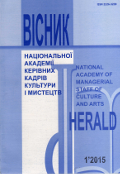ХУДОЖНЬО-ЕСТЕТИЧНІ ОСОБЛИВОСТІ ІНТЕР’ЄРІВ ЗАКЛАДІВ ХАРЧУВАННЯ ЯК ОСЕРЕДКІВ ДОЗВІЛЛЯ І РОЗВАГ
Artistic and aesthetic features of restaurant institutions as centres of leisure and entertainment
Author(s): Roxolana DyachenkoSubject(s): Psychology, Sociology, Cultural Anthropology / Ethnology
Published by: Національна академія керівних кадрів культури і мистецтв
Keywords: interior; dining; leisure; entertainment; art and aesthetic solutions
Summary/Abstract: This article analyses the artistic and aesthetic features of the modern restaurant interior solution with accentuation on their leisure and entertainment component. The author stresses the need of the combination of three-dimensional structures, especially decorative and artistic interior decoration catering with the function of satisfying the needs of visitors in the rest and entertainment.Nowadays the trend of the dynamic changes in the structure and meaning of spending free time among different population groups is more obvious. It requires a reorientation of traditional and functions and technologies which are typical for catering.The purpose of the article – to outline the main aspects of artistic and aesthetic solution of the modern restaurant interiors as centres of leisure and entertainment industry.The accentuation on leisure aspect has the requirements to the modern artistic and cultural practices embodied in interior design and can determine fairly wide creative approach to the formation of space and the internal environment of restaurant based on the artistically motivated criteria. Thus, the interiors without the imagery and drama are not interested because a visitor taste is influenced by various artistic designer findings in this area. Today mostly visitors are attracted by "the interior" with the same enthusiasm as by "the chef and his dishes". Therefore, the modern interior of restaurant is characterized by a trend of the mixing two distinctive environments "Environment of action" and "environment of perception".It is clear that the interior of the restaurant doesn’t have the clear features of belonging to the one type, of course, there are many techniques and methods of its decision primarily planning structure and three-dimensional composition, which cannot exist without the mentioned functional relationships, and performing the desired "leisure accent".So the functional organization plays a significant role in the formation of a three-dimensional solutions, and restaurant interiors. In our opinion, the aesthetically pleasing and artistic direction of solving interiors is the main feature of leisure orientation.The dining often combined two basic premises – kitchen (handout) and dining room. The last one is becoming increasingly necessary not only as a functional centre, but as a zone of the emotional attraction and entertainment for visitors. The factors belong to such extension of the functions such as the cooking on the open fire in front of visitors, aquarium with live fish or crayfish for selecting and cooking, the conveyor with colourful dishes on plates or tricks of the bartender at the bar.It is usually distinguished two forms of service process – self-service and with a waiter. The service with a waiter takes the visitor much longer, but creates a comfort, having a good time, entertainment and the opportunity to watch the events around.The specific predictability of visitors’ actions allows to make free zoning seats, their various groupings, to create some isolation by decorative protective screens, multi-level floors, walls and partitions plasticity or local lighting installation. Due to these technological features of the service, the overall spatial form of the hall can have a difficult solution with the release of a purely entertainment zones – dance floor, stage, billiards and sofa zones at the bar or fireplace, buffet or hookah.In general all spectacular recreational places are characterised by the relative increasing space for comfort, achieved by the specific decorative finishing, quality furniture, which often being produced customized, unique serving consistent with the overall interior design according its idea.Consequently, the domestic and socio-cultural filling of space combines the process collective dining and entertainment in a public place which indicates the need for the formation of the hotel and restaurant interior is equally combined to pragmatic and aesthetic aspect. The utility of such places requires constancy in their functionality, as the main function of them is public catering. Although this function is constant, there are different interpretations of it, including in terms of a combination of other social functions, including the provision of leisure and entertainment, which influences the artistic and aesthetic features of the interior.
Journal: Вісник Національної академії керівних кадрів культури і мистецтв
- Issue Year: 2015
- Issue No: 1
- Page Range: 132-136
- Page Count: 5
- Language: Ukrainian

